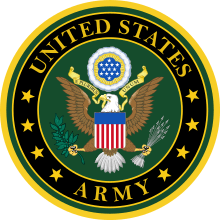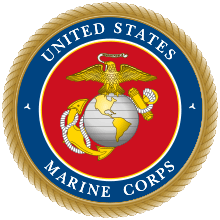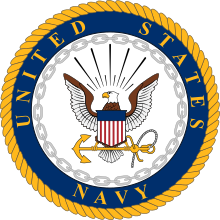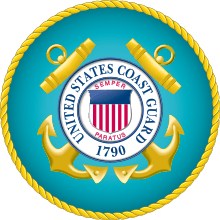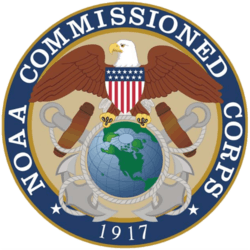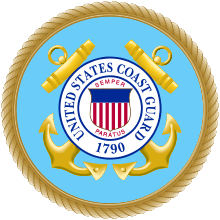Uniformed services of the United States
The United States has eight federal uniformed services that commission officers as defined by Title 10 and subsequently structured and organized by Title 10, Title 14, Title 32 and Title 42 of the U.S. Code.
Uniformed services
The uniformed services are, in order of precedence, when in formations:[10][11]
- United States Army
- United States Marine Corps
- United States Navy
- United States Air Force
- United States Space Force
- United States Coast Guard
- United States Public Health Service Commissioned Corps
- National Oceanic and Atmospheric Administration Commissioned Officer Corps
Each of the uniformed services is administratively headed by a federal executive department and its corresponding civilian Cabinet leader.
Federal executive departments
United States Department of Defense (DoD)
Department of the Army (DA)
- United States Army (USA): 14 June 1775
Department of the Navy (DON)
- United States Marine Corps (USMC): 10 November 1775
- United States Navy (USN): 13 October 1775
Department of the Air Force (DAF)
- United States Air Force (USAF): 18 September 1947
- United States Space Force (USSF): 20 December 2019
The order of precedence within the U.S. Department of Defense is set by DoD Directive 1005.8 and is not dependent on the date of creation by the U.S. Congress.
United States Department of Homeland Security (DHS)
- United States Coast Guard (USCG): 4 August 1790
Prior to 1967, the U.S. Coast Guard was a part of the U.S. Department of the Treasury. In 1967 it became a part of the U.S. Department of Transportation. In 2002 it was placed under the DHS. During time of war it may be transferred to the Department of the Navy, under the Department of Defense.
United States Department of Health and Human Services (HHS)
- United States Public Health Service Commissioned Corps (PHSCC): 4 January 1889
The Corps is headed by the Surgeon General of the United States.
United States Department of Commerce (DOC)
- National Oceanic and Atmospheric Administration Commissioned Officer Corps (NOAA Corps): 22 May 1917.
The NOAA Corps was created as the United States Coast and Geodetic Survey Corps, a component of the United States Coast and Geodetic Survey, on 22 May 1917. It was removed from the Coast and Geodetic Survey and became a component of the Environmental Science Services Administration (ESSA) as the Environmental Science Services Administration Corps (ESSA Corps) upon the establishment of ESSA on 13 July 1965. The ESSA Corps became the NOAA Corps as a component of NOAA when ESSA was abolished and NOAA simultaneously was created on 3 October 1970. Under all three names, the Corps has been an element of the Department of Commerce throughout its existence.
Statutory definition
The eight uniformed services are defined by :
The term "uniformed services" means—
(A) the armed forces;
(B) the commissioned corps of the National Oceanic and Atmospheric Administration; and
(C) the commissioned corps of the Public Health Service.
The six uniformed services that make up the United States Armed Forces are defined in the previous clause [lower-alpha 3]
The term "armed forces" means the Army, Navy, Air Force, Marine Corps, Space Force, and Coast Guard.
All eight uniformed services are subject to the provisions of 10 USC 1408, the Uniformed Services Former Spouses Protection Act (USFSPA).[13]
U.S. Armed Forces
Six of the uniformed services make up the U.S. Armed Forces, five of which are within the U.S. Department of Defense. The Coast Guard is part of the Department of Homeland Security and has both military and law enforcement duties. Title 14 states that the Coast Guard is part of the armed forces at all times, making it the only branch of the military outside the Department of Defense. During a declared state of war, however, the President or Congress may direct that the Coast Guard operate as part of the Department of the Navy.[14] The U.S. Public Health Service Commissioned Corps, along with the NOAA Commissioned Corps, operate under military rules with the exception of the applicability of the Uniform Code of Military Justice, to which they are subject only when militarized by executive order or while detailed to any component of the armed forces.[15]
Reserve components of the United States Armed Forces are all members of the military who serve in a reserve capacity. The National Guard is an additional reserve military component of the Army and Air Force, respectively, and is composed of National Guard units, which operate under Title 32 and under state authority as the Army National Guard and Air National Guard. The militia that later became the National Guard was first formed in the Colony of Virginia in 1607 and is the oldest uniformed military force founded in the New World. The National Guard can also be mobilized by the President to operate under Federal authority through Title 10. When acting under federal direction, the National Guard is managed by the National Guard Bureau, which is a joint Army and Air Force activity under the Department of Defense,[16][17][18] with a 4-star general[16][17] from the Army or Air Force appointed as its top leader. However, in Federal service command and control of National Guard organizations will fall under the designated Geographic or Functional Combatant Commander. The National Guard of the United States serves as a reserve component for both the Army and the Air Force and can be called up for federal active duty in times of war or national emergencies.[16][17]
Non-armed uniformed services
- The National Oceanic and Atmospheric Administration Commissioned Officer Corps (NOAA Corps) is a uniformed branch of the National Oceanic and Atmospheric Administration (NOAA), which is under the Department of Commerce.
- The United States Public Health Service Commissioned Corps (PHSCC) is the uniformed personnel system of the United States Public Health Service, which is under the Department of Health and Human Services.
Commissioned officers of NOAA and PHS wear uniforms that are derived from U.S. Navy and Coast Guard uniforms, except that the commissioning devices, buttons, and insignia reflect their specific service. Uniformed officers of NOAA and PHS are paid on the same scale as members of the armed services with respective rank and time-in-grade. Additionally, PHS Officers are covered by the Uniformed Services Employment and Reemployment Act and the Servicemembers Civil Relief Act (formerly the Soldiers and Sailors Civil Relief Act).
PHS and NOAA consist of commissioned officers only and have no warrant officer ranks or enlisted ranks. Commissioned officers of the PHS and NOAA may be militarized by the President.[19] Because they are commissioned officers, they can be classified as prisoners of war under the Geneva Conventions, if captured by a belligerent entity. The United States Coast and Geodetic Survey (USC&GS), a predecessor to NOAA, originally began commissioning its officers so that if captured while engaged in battlefield surveying, they would be protected under the Law of Armed Conflict and could not be tried or executed as spies. The USC&GS Commissioned Officer Corps became the Environmental Science Services Administration Corps (ESSA Corps), upon the creation of the Environmental Science Services Administration (ESSA) on 13 July 1965, then became the NOAA Corps upon the creation of NOAA on 3 October 1970. The PHS traces its origins to a system of marine hospitals created by "An Act for the relief of sick and disabled seamen", passed by Congress in 1798; it adopted a military model of organization in 1871.[20][21]
See also
References
Informational notes
- With the establishment of the Continental Army.
- Maximum age for first-time enlistment is 35 for the Army,[1] 28 for the Marine Corps, 34 for the Navy, 39 for the Air Force[2] and 27 for the Coast Guard.[3]
- Amended by National Defense Authorization Act for Fiscal Year 2020.[12]
Citations
- "United States Army". Goarmy.com. Archived from the original on 29 June 2013. Retrieved 18 June 2013.
- "Contact Us: Frequently Asked Questions - airforce.com". airforce.com. Archived from the original on 20 April 2015. Retrieved 1 April 2015.
- "Plan Your Next Move to Become a Coast Guard Member". Enlisted Opportunities. U.S. Coast Guard. Archived from the original on 28 April 2014. Retrieved 27 April 2014.
- "QUICK FACTS AND FIGURES". Selective Service System. Archived from the original on 12 June 2018. Retrieved 6 November 2018.
- "Number of births in the United States from 1990 to 2016 (in millions)". Statista. 2018. Archived from the original on 7 November 2018. Retrieved 6 November 2018.
- "ARMED FORCES STRENGTH FIGURES FOR JUNE 30, 2020".
- IISS 2020, p. 46.
- "National Defense Budget Estimates for FY 2021" (PDF). United States Department of Defense. April 2020.
- "Defence Expenditure of NATO Countries (2012-2019)" (PDF). NATO Public Diplomacy Division. 25 June 2019. Retrieved 18 July 2019.
- "DoD Directive 1005.8" (PDF).
- https://www.whitehouse.gov/salutetoamerica/
- "National Defense Authorization Act for Fiscal Year 2020". Title IX, Subtitle D, Section 952(b)(2), Act of 2019 (PDF). United States Congress. p. 904.
- "10 U.S. Code § 1408 - Payment of retired or retainer pay in compliance with court orders". Legal Information Institute. Cornell Law School. Retrieved 26 July 2020.
- 14 U.S.C. § 3
- "UCMJ S 802. Art. 2. Subs. (a). Para. (8)".
- "H.R. 4986: National Defense Authorization Act for Fiscal Year 2008".
- "H.R. 4986: National Defense Authorization Act for Fiscal Year 2008 full text".
- "SEC. 1812. ESTABLISHMENT OF NATIONAL GUARD BUREAU AS JOINT ACTIVITY OF THE DEPARTMENT OF DEFENSE".
- PHS is under Title 42 & 46 U.S.C.
- United States Code. Title 5. Part III. Chapter 21. S 2101.
- "History of the Office of Surgeon General". Retrieved 9 April 2014.
